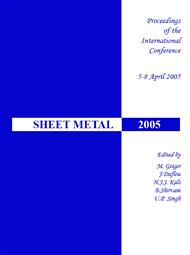p.721
p.729
p.737
p.745
p.753
p.763
p.771
p.779
p.787
Optimisation of Springback Predicted by Experimental and Numerical Approach by Using Response Surface Methodology
Abstract:
Bending has significant importance in the sheet metal product industry. Moreover, the springback of sheet metal should be taken into consideration in order to produce bent sheet metal parts within acceptable tolerance limits and to solve geometrical variation for the control of manufacturing process. Nowadays, the importance of this problem increases because of the use of sheet-metal parts with high mechanical characteristics (High Strength Low Alloy steel). This work describes robust methods of predicting springback of parts in 3D modelling subjected to bending and unbending deformations. Also the effects of tool geometry in the final shape after springback are discussed. The first part of this paper presents the laboratory experiments in wiping die bending, in which the influence of process variables, such as die shoulder radius, punch-die clearance, punch nose radius and materials properties were discussed. The second part summarises the finite element analysis by using ABAQUS software and compares these results with some experimental data. It appeared that the final results of the FEM simulation are in good agreement with the experimental ones. An optimisation methodology based on the use of experimental design method and response surface technique is proposed in the third part of this paper. That makes it possible to obtain the optimum values of clearance between the punch and the die and the optimum die radius which can reduce the springback without cracking and damage of product.
Info:
Periodical:
Pages:
753-762
Citation:
Online since:
May 2005
Authors:
Keywords:
Price:
Сopyright:
© 2005 Trans Tech Publications Ltd. All Rights Reserved
Share:
Citation:


